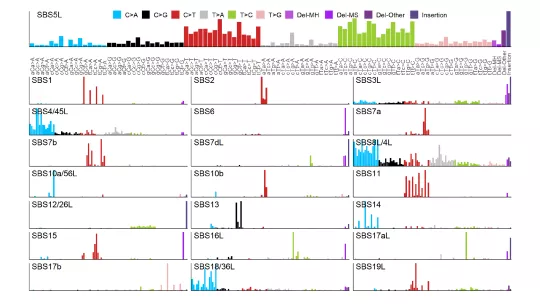Images
As an approach to personalised medicine, the study proposes that “mutational footprints” of DNA repair are a promising predictive genetic marker for determining which tumours will respond to certain therapies.
The results have been published in Nature Communications.
Cancer therapy increasingly relies on a personalised approach, where genetic changes in an individual tumour can be used to determine the best therapeutic strategy. In many cases thus far, these genetic changes included a so-called “driver mutation” that would predict response to a drug. For instance, mutations in the BRAF gene in melanoma predict response to BRAF inhibitor drugs, and amplifications in the ERBB2 gene in breast cancer predict response to ERBB inhibitor drugs.
However, these examples of successful drug markers are still quite rare. For many mutated driver genes, specific drugs to target them are not available. Moreover, tumours of different patients show high variability in response to drugs and such variability is often not linked to driver gene mutations.
Researchers at IRB Barcelona, led by Dr. Fran Supek, ICREA researcher and head of the Genome Data Science lab, have found that so-called “mutational signatures” can accurately predict the activity of various drugs applied to cancer cells originating from many types of tumours. These “mutational signatures” do not originate from driver genes; instead, they reflect a collection of mutations found across the entire genome of a tumour. The mutational signatures can reflect, for example, that the tumour has difficulties in copying or repairing DNA, which may make it more amenable to therapy.
“We have performed statistical analysis using machine-learning methods, considering jointly cancer cell genomes, their response to various drugs, and their response to gene editing experiments. Surprisingly, our analysis revealed that the 'classical' genetic markers such as driver gene mutations or copy-number changes are often less powerful than the mutational signature genetic markers in predicting drug response,” explains Dr. Supek.
Various DNA repair deficiencies make cancer cells easier to target by many drugs
This study found many statistical predictions linking an observed mutational signature with the response (or lack of) towards a cancer drug. It was previously known that a certain type of deficiency in so-called BRCA genes—which can cause breast, ovarian and prostate cancers—predicts response to drugs targeting BRCA deficiency. This deficiency also leaves a mutational signature in the genome of certain types of deletions (removed DNA), which can signal that the tumour is treatable by drugs targeting BRCA deficiency.
In the current study, IRB Barcelona researchers, headed by the Marie Curie postdoctoral fellow Dr. Jurica Levatić, now a postdoctoral researcher in the Jozef Stefan Institute in Slovenia, have shown that this is only one example of many: various types of DNA repair deficiency, such as defects in the 'genomic spellchecker' (DNA mismatch repair), can predispose cancer cells to sensitivity to certain drugs. Given that tumours have impaired DNA repair mechanisms, these predicted therapies would have a greater capacity to kill cancer cells and spare healthy ones.
Prior exposure to mutagenic chemicals, including drugs, may confer cancer cells resistance to future therapies
The statistical and machine-learning analyses in this work, jointly implemented by Marina Salvadores, a PhD student at the Genome Data Science lab, can connect databases from prior experiments in which many drugs had been tested on cancer cells growing in vitro (in the lab). Moreover, this study also integrated “gene editing” experimental data, where CRISPR was used to switch off various drug target genes in the same types of cancer cells. This approach allowed the researchers to link drug target genes to drug treatments, thus adding confidence to their main finding that mutational signatures predict drug activity in cancer.
Interestingly, the cancer cells that bear genomic “scars” (mutational signatures) of previous exposure to mutagenic chemicals tended to be resistant to diverse chemotherapeutic drugs. One possible explanation for this is based on the known mechanism by which, for example, brain cancer cells can switch off their DNA repair systems during treatment with the mutagenic drug TMZ, which could permanently covert them into hardy, hypermutating cells resistant to a range of future treatments.
The study suggests that this sort of adaptation may be common in cancer. This has potential implications as tumours caused by mutagen exposure, e.g. lung exposure to tobacco or skin exposure to UV light, may be more difficult to treat, since the cells may harbour a long-term “memory” of dealing with DNA damage.
The algorithms used to identify the mutational signatures and link them to drug vulnerabilities are open access and can be found HERE. Future work by the lab will focus on testing these prediction algorithms on patients’ data, thereby overcoming the challenge of the scarcity of public genomic data for patients that correlate with randomized clinical trials.
This work has been funded by the EU through the ERC Starting Grant “HYPER-INSIGHT”,
the Horizon 2020 RIA project “DECIDER”, and the Spanish Ministry of Science and Innovation.
Related article:
Mutational signatures are markers of drug sensitivity of cancer cells
Jurica Levatić, Marina Salvadores, Francisco Fuster-Tormo & Fran Supek
Nature Communications (2022) DOI: 10.1038/s41467-022-30582-3
About IRB Barcelona
The Institute for Research in Biomedicine (IRB Barcelona) pursues a society free of disease. To this end, it conducts multidisciplinary research of excellence to cure cancer and other diseases linked to ageing. It establishes technology transfer agreements with the pharmaceutical industry and major hospitals to bring research results closer to society, and organises a range of science outreach activities to engage the public in an open dialogue. IRB Barcelona is an international centre that hosts 400 researchers and more than 30 nationalities. Recognised as a Severo Ochoa Centre of Excellence since 2011, IRB Barcelona is a CERCA centre and member of the Barcelona Institute of Science and Technology (BIST).









